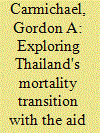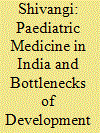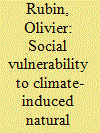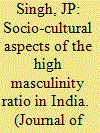| Srl | Item |
| 1 |
ID:
103962


|
|
|
|
|
| Publication |
2011.
|
| Summary/Abstract |
The project Thai Health-Risk Transition: A National Cohort Study seeks to better understand the health implications of modernisation and globalisation forces impacting on Thailand. As part of its 'look-back' component this paper seeks, using available life tables, to document the country's post-war mortality transition. The onset of transition through mass campaigns of the late 1940s and 1950s is first discussed before attention turns to the life tables. They are predictably far from flawless, but careful analysis does permit trends that have seen around 30 years added to life expectancy to be traced, and age patterns of improved survivorship and their relation to initiatives to improve health to be examined. The broad benefits generated by mass campaigns, ongoing improvements in infant and early childhood mortality, and a phased impact of the expansion of primary health care in rural areas on adult survival prospects after the mid-1970s are demonstrated. The paper also investigates the consequences for mortality of a motorcycle-focused rapid increase in road fatalities in the late 1980s and early 1990s and the HIV/AIDS epidemic that developed after 1984.
|
|
|
|
|
|
|
|
|
|
|
|
|
|
|
|
| 2 |
ID:
170174


|
|
|
|
|
| Summary/Abstract |
This article argues that the poor state of paediatric medicine in India still restrains and often prevents the healthy development of far too many young Indians. Infants as junior-most citizens deserve diligent care, as they have legal entitlements to specialised medical services, ensuring their survival and healthy growth, ultimately for the benefit of the entire nation. The article first traces the somewhat stunted colonial institutional development of paediatric medicine in India. It then proceeds to perform a critical analysis of the continuing harm of negligence concerning the health and upbringing of India’s vulnerable infants, challenging the state to become more committed to integrated child development.
|
|
|
|
|
|
|
|
|
|
|
|
|
|
|
|
| 3 |
ID:
185094


|
|
|
|
|
| Summary/Abstract |
In 1992 the 73rd amendment to the Indian constitution called on states to create and empower rural local governments. Despite the amendment, however, there is variation in the extent of decentralization of power from states to rural local governments in the country. How has this process of decentralization influenced health outcomes in India? The research note addresses this question by collecting preliminary data on political, administrative and fiscal decentralization and examining trends in different dimensions of decentralization and infant mortality rates among select states (Assam, Rajasthan, Kerala and Tamil Nadu) from 1994 to 2017. These states display disparities in the outcome of interest and infant mortality, and have income levels that do not explain all the variation in infant mortality trends. Preliminary results demonstrate the need to adopt a multidimensional approach toward studying the consequences of decentralization.
|
|
|
|
|
|
|
|
|
|
|
|
|
|
|
|
| 4 |
ID:
132407


|
|
|
|
|
| Publication |
2014.
|
| Summary/Abstract |
This paper conducts an analysis of the socioeconomic determinants of Vietnam's cross-provincial variations in natural disaster vulnerability. The purpose is twofold: (i) to capture disaggregated vulnerability variations normally obscured by national statistics, thereby providing more nuanced insights into Vietnam's vulnerability to natural disasters; and (ii) to take advantage of the fact that the overall political system and key institutional structures to a large extent are constant across Vietnam's provinces, which makes the analysis a novel addition to the many disaster studies based on cross-national variations. The paper's analysis indicates that much of Vietnam's cross-provincial variations in natural disaster fatalities and economic costs can be explained by differences in key socioeconomic factors. High provincial rates of inequality, poverty and infant mortality, for instance, appear to drive up natural disaster fatalities. Local adaptation efforts should focus as much on these broader socioeconomic dimensions as they focus on the geophysical susceptibility to natural hazards of individual areas.
|
|
|
|
|
|
|
|
|
|
|
|
|
|
|
|
| 5 |
ID:
101496


|
|
|
|
|
| Publication |
2010.
|
| Summary/Abstract |
The paper aims to explicate those factors accountable for the continuing imbalance in the sex ratio and its further masculinization over the whole of the 20th century. Here it is contended that the traditional practice of female infanticide and the current practice of female foeticide in the contemporary period, especially in the north-west and Hindi-speaking states, have significantly contributed to the high masculinity ratio in India. In addition, increasingly higher survival ratios of male children, particularly from the 1951 census onward, have been the prime reason for a declining proportion of females in the Indian population. As the Indian value system has been imbued with a relatively higher preference for sons, improvements in health facilities have benefited males more than females, giving rise to a highly imbalanced sex ratio in the country. This scenario, however, has steadily tended to alter in favour of greater balance in sex ratio.
|
|
|
|
|
|
|
|
|
|
|
|
|
|
|
|